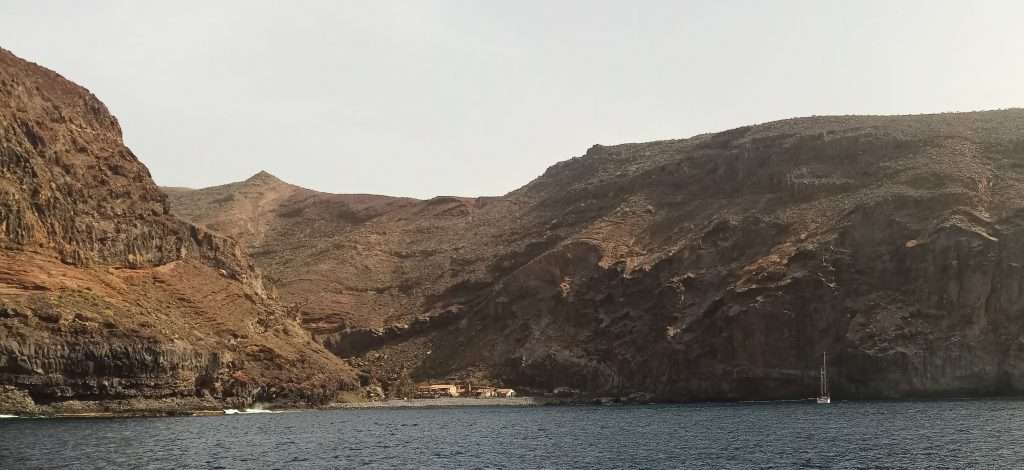On paper, the Canaries islands are the ideal cruising ground. Seven main islands stretched across 250 miles at the latitude of Southern Morocco. Guaranteed sunshine, great touristic infrastructure including hundreds of flights daily from most European cities, and all within the EU.
Sounds like paradise, but do they live up to their reputation?
I spent five weeks there with Apsara to find out.
The good
Sunshine
If it’s sunshine you’re after, look no further, it’s virtually guaranteed. Lanzarote gets an average of nearly 3000 hours of sunshine a year, twice as much as the UK. The two Easternmost islands, Lanzarote and Fuerteventura, are closer to the Sahara than to Tenerife, and it shows, their landscape is rather barren, and tap water there is desalinated. But it’s never too hot either. In fact, in the evenings and early morning, a light jumper might make life more comfortable (during the day, a Tee shirt, or a swimsuit, will do just fine).
Of course, the guaranteed sunshine attracts a constant flow of tourists. A lot of restaurants have menus in three languages, and virtually everyone there speaks English.
Food and wine
at least as cheap and as good as in continental Spain. Most of the islands produce decent wine, and some of them also produce interesting cheeses. La Palma exports large quantities of fruits, especially bananas, but also mangoes, avocados, papaya, kakis….
It’s in the EU
Yes, you can pay for your shopping in euros, and if you’re a EU citizen, you can stay there for as long as you want. That’s why Gomera is full of Germans!
The Bad
Wind
The Canaries are South East of the Azores high, so the prevailing winds are between North and East.
They are also very high islands, and this has a dramatic effects on the sailing conditions. Wind shadows extend a long, long way out in the lee of the islands, with calm conditions virtually guaranteed south of Gomera and Southwest of Tenerife for example, in a well established North-easterly airflow. This translates into a lot of motoring. Of the thousand miles I “sailed” in the canaries, nearly a third was motoring. And then there are the infamous “acceleration zones” where the wind funnels along the very high coasts and increases by as much as 25 knots in the space of a few hundred meters. White horses on the horizon ahead are a sign that it’s time to reef furiously. For all these reasons, the forecast should be taken with a solid pinch of salt, as the wind is sometimes as much as 20 knots more, or less, than what the forecast promised.

Shelter
Because the prevailing winds and swell are usually from the north, most harbours in the Canaries are poorly protected against southerly winds. It can get so bad that some harbours close in bad Southerly weather. This is why we were denied access to both marinas in Santa Cruz de Tenerife in a South-easterly blow. In Las Palmas de Gran Canaria that same day, a number of boats dragged their anchors and had to be rescued, and even within the marina, life was pretty uncomfortable.
Most usual anchorages become untenable in these conditions. The only harbours in the Canaries where I would want to be in a Southerly gale are Arecife (preferably) or Marina Rubicon (possibly), both in Lanzarote. Even the marina in Las Palmas, the biggest harbour in the islands, isn’t great in these conditions.
There are few good anchorages in the Canaries, and most of them are crowded, sometimes with long term residents who get very territorial with newcomers. And if it’s not crowded, you can assume it’s going to be very rolly! And of course, none of the usual anchorages in the Canaries are safe in southerly winds, and a heavy North-westerly swell from a storm in mid-Atlantic can make some of them rather uncomfortable or even untenable.
and the ugly…
Whimsical marina staff who will ask you to leave a half empty marina because you did not reserve a berth a week in advance (Graciosa), or force you to anchor outside the harbour and come to the office with your dinghy, then make you wait for over an hour before telling you that they don’t have room (Las Palmas, they eventually found us a berth), or refuse to let you in at all in rough southerly weather (both marinas in Santa Cruz de Tenerife, we had to beat back to Las Palmas), or measure the boat as soon as you arrive, so they can charge you more (Marina Rubicon), or won’t answer the phone before 11 am when you are trying to find out if you can shelter there from incoming bad weather (San Sebastian de la Gomera). Expect to spend a lot of time checking in and out of marinas. And most marinas are on the expensive side, too.
The only harbour I visited where the staff were both friendly and helpful was Tazacorte, on the West coast of La Palma, where the security man was waiting for me at 10 o’clock at night (I had rung ahead) and made sure I had the boat properly tied up before giving me the key to the shower. Check in was completed the following morning in less than five minutes, a nice change from Las Palmas where it usually takes over an hour.
So, are the Canaries a good sailing area?
Heck no.
If you want serious winter sailing, try the Caribbean instead. There, you’ll get reliable winds, beautiful, safe anchorages and nearly as much sunshine.
And if you just want to laze around in the sun, drinking cheap wine, why bother with a sailing boat? Just hire a motor cruiser, or even better, an apartment in Puerto del Carmen….